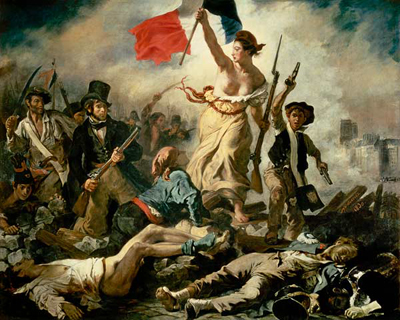 |
Peoples' movements and protests |
 |
|
MobilizationsThe republican movementThe Nordic popular movevment cultureThe Communist movementThe Islamist movementThe Global Justice MovementBack to Total movementsBack to Civil rights movementsBack to main page
|
Republicanism
After the middle of the 18th century, a new popular movement tradition was born in Western Europe – to gather in a demonstration, a mass meeting or a petition to speak out as the People and make demands. Or rather was raised again – during the Puritan revolution in England, such things had occurred from time to time. Obviously, it was all a consequence of often successful bread seizures, when the government was forced to take into account local popular demands, instead of acting as a government with divine power. This tradition very soon went very far, and began to demand a mortgage in the government power. At first a little hesitant in England in connection with parliamentary elections, when the direct producers sometimes demanded the right to vote. Then in England’s North American colonies, where a broad popular movement in the 1770s demanded to be allowed to approve taxes before these were imposed on them. Then in Holland where the lower bourgeoisie began to arm themselves in the early 1780s to defend ”freedom” against various kinds of monopolists. And finally in France, where the people began to compile their demands to the parliamentarians who was convened by the king to deal with the country’s disastrous finances. The background was the world market system’s first great wave of speculation 1770-1795, when production and labor were increasingly seen as dubiously useful by the capitalists who instead invested in short-term profitable pyramid schemes with the approval of the government. The result was unemployment and economic chaos. The French Revolution,
a consequence of the above-mentioned parliament’s
attempt to deal with an economy destroyed by speculation, became
the first great success of this popular movement tradition. During
this
time, after ancient models, people began to call the desired society ”republic” – after ”res
publica”, ”the common cause”. First, all people were, in principle, equally valuable and should have the same rights and obligations in society. Secondly, all civil servants were accountable to them for the public functions they exercised, and also possible to repeal if they didn’t conduct. And third, it was imagined that relations within the republic were reciprocal and based on ”brotherhood” instead of power and market relations. To realize these demands, the Republicans imagined, with their experience of the French Revolution, one must conquer the state apparatus and use it as a means of power. Of course, there were many in the movement who were willing to compromise, sometimes heavily, on one or more of these demands. Not least because the Republican movement had such a motley base, consisting of everyone who stood outside the rather narrowly recruited power establishment. But the Republican movement also proved to be extremely macho, and rather more hostile to women’s rights than the aristocracy was. But during the entire period between the French Revolution and the revolutions of 1848, they were still able to function as a movement contemporariness, i.e support and help each other just by being there. This despite the fact that the movement took on many different expressions. There were law-abiding reform movements, e.g the English parliamentary reform movement or the French movement to uphold the civil gains of the revolution, which the government did everything in its power to erode. There were secret societies that dreamed of repeating the revolution through a willful and rock-hard organization, beginning in the Italian Carbonari and the Spanish Liberals in the 1810s and then multiplying themselves in France after the successful barricade battles there in 1830. There were peasants who defended collective usufruct rights in forests and pastures against increasingly commercial larger owners, often from aristocratic families but just as often foreign people from the cities. There were also the often tradition-laden artisan companionships with the aim of functioning as trade unions, unemployment funds and organizers of vocational training, which became more and more republican-influenced as time went on. And finally, the bread revolts that had instigated this tradition. As the bourgeoisie were coopted into government power, however, it began to fall away from the Republican Alliance, beginning in England from the parliamentary reform of 1832, and then more generally on the continent through the revolutions of 1848. The successor would then, for better or worse, become the labour movement, the heirs of the artisans’ companionshiops, who took over or upheld both the republicans’ ideal of equality and their belief that the good society would be organized through the state. Reading
|
